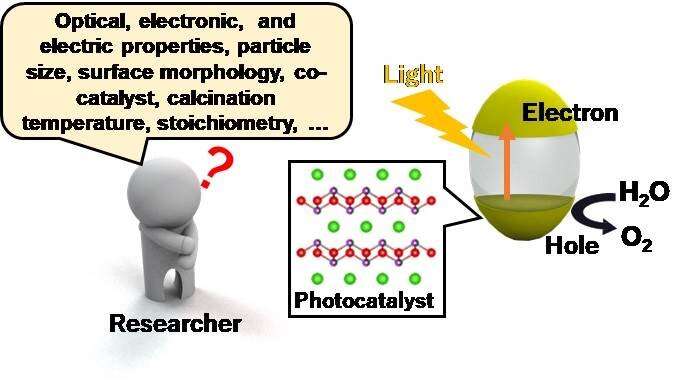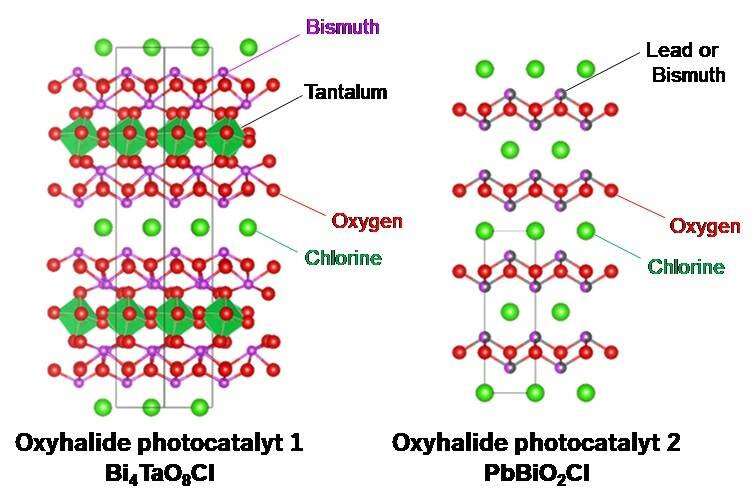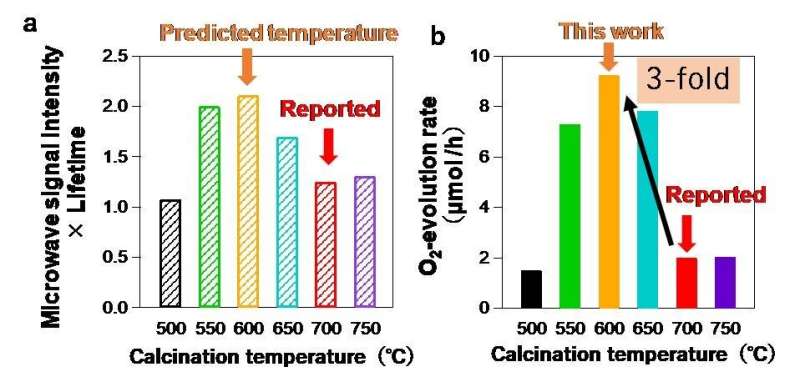(Right) Schematic of photocatalytic reaction. (Left) Many factors that affect the photocatalytic performance. Credit: Osaka University
Osaka University researchers have studied the photocatalytic activity of oxyhalide materials and were able to demonstrate a relationship between parameters measured by time-resolved microwave conductivity (TRMC) and oxygen generation. Using the relationship, they optimized the processing temperature for the synthesis of the photocatalyst PbBiO2Cl, resulting in a three-fold improvement in the apparent quantum efficiency compared with previous reports. It is hoped that the findings will allow for high throughput screening and efficient photocatalyst development.
Photocatalysts that harness light energy and use it to split water into hydrogen and oxygen could make hydrogen a potential clean energy source. However, the optimization of photocatalyst candidate materials usually requires a considerable time investment. Now, researchers at Osaka University have demonstrated a link between easy-to-measure quantities and catalyst performance that could provide a rapid evaluation method.
The conversion of light energy to chemical energy using photocatalysts has been widely reported, but the continual optimization of photocatalytic materials is critical for their successful application. The properties of photocatalysts, including their surface area, crystallinity and various electronic features, affect their activity. These properties can be influenced by the techniques and specific conditions used to prepare them, thus leading to a broad range of materials that could be evaluated.
Testing material is a time-consuming process that has yet to be accelerated—until now. In a report published in ACS Energy Letters, Osaka researchers have shown the relationship between time-resolved microwave conductivity (TRMC) measurements and the photocatalytic performance of semiconductor materials. TRMC is a process that allows photocatalysts to be evaluated in powder form, which leads to significantly higher throughput.
Crystal structure of oxyhalide photocatalyts 1 and 2. Credit: Osaka University
"We have been able to show that the oxygen evolution rate of a photocatalyst—which is a measure of activity—can be determined from the photoconductivity and the half-lifetime determined by TRMC," explains study lead author Hajime Suzuki. "Applying this relationship to materials makes evaluating their potential much more efficient."
The researchers used their findings to determine the optimum processing temperature for a material that had not been extensively studied, PbBiO2Cl, and were able to produce an analogue that had an apparent quantum efficiency of 3 percent—three times higher than had been achieved in previous studies using higher processing temperatures.
(a) Product of microwave photoconductivity intensity and its lifetime of oxyhalide photocatalyt 2 vs calcination temperature. The microwave measurements suggest the optimal temperature of 600 ℃ that is 100 ℃ lower than the reported one. (b) O2-evolution rate of oxyhalide photocatalyt 2 prepared by different calcination temperature. Credit: Osaka University
"We hope that the principles of our findings can be widely applied to improve the efficiency and ease of screening materials, finding candidates, and choosing synthesis conditions," study corresponding author Akinori Saeki explains. "In terms of the broader picture, high throughput processes could accelerate the development of cleaner energy solutions."
More information: Hajime Suzuki et al. Photoconductivity–Lifetime Product Correlates Well with the Photocatalytic Activity of Oxyhalides Bi4TaO8Cl and PbBiO2Cl: An Approach to Boost Their O2 Evolution Rates, ACS Energy Letters (2019). DOI: 10.1021/acsenergylett.9b00793
Provided by Osaka University

























